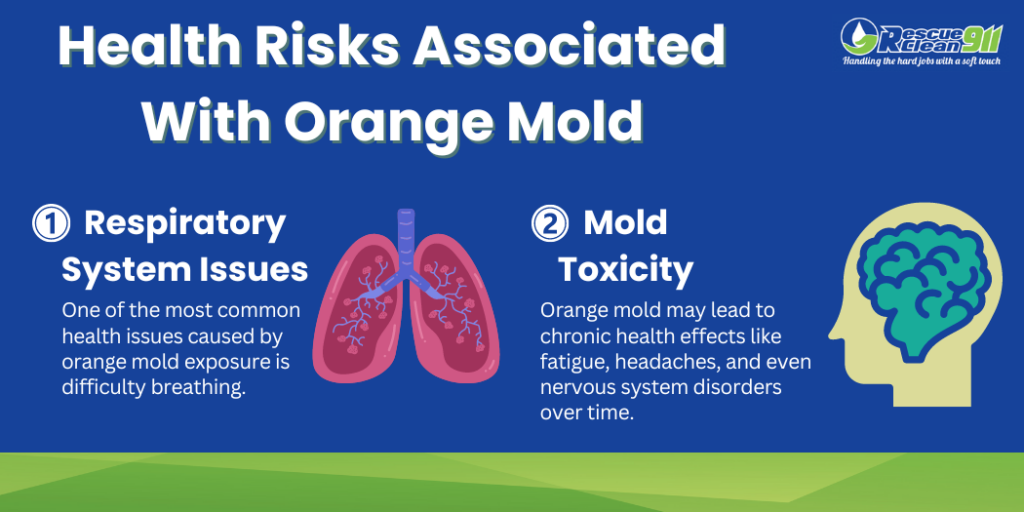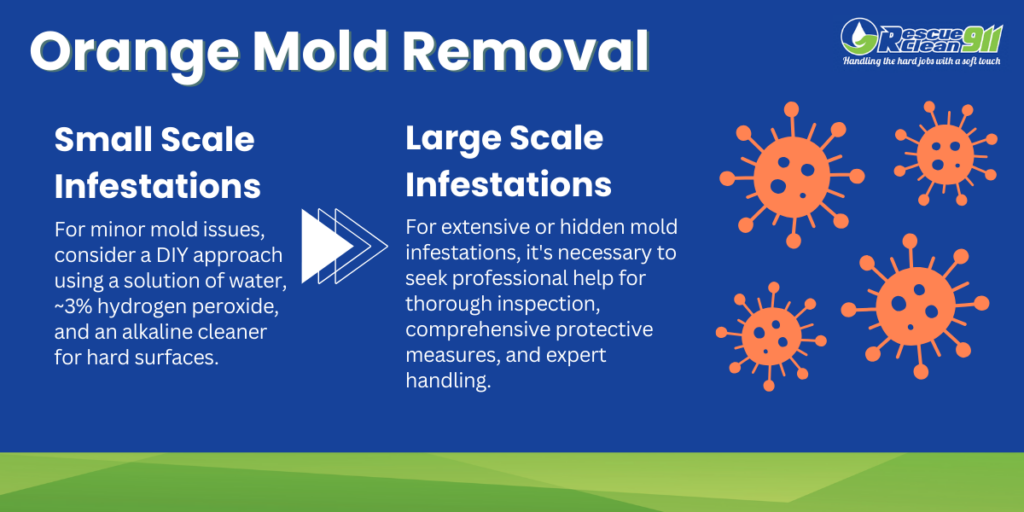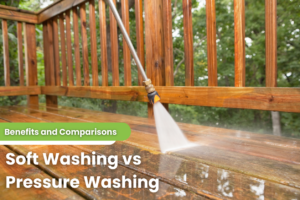Orange Mold: Health Risks & How to Get Rid of It
Unnoticed and often underestimated, orange mold is a common issue that can emerge in your bathroom or on houseplants. This type of mold is more than just an unsightly nuisance; it could also affect your home’s health and cleanliness. Therefore, understanding and identifying orange mold is essential for maintaining a safe living environment.
Orange mold growth is a common intruder that is easy to miss in our standard home cleaning activities. Its ability to grow on surfaces with substantial moisture and organic material, as well as in conditions that provide a reliable food source. Unfortunately, our homes often meet all of these criteria.
While we often hear about black mold and its dangers, there are other types we should consider – one of which is orange mold. Understanding the differences, causes, and health risks associated with each is a significant first step in ensuring the safety of your living environment. Simply cleaning the orange stain may fall short; we need to address the root cause, identify risk areas, and, in many cases, invest in comprehensive mold remediation.
When handling a mold problem, knowledge and swift action are key. This guide equips you with the necessary information allowing you to address this issue head-on, creating a healthier environment for you and your loved ones.
What is Orange Mold?
Orange mold is an organism falling under the slime mold category which includes types such as Fuligo Septica. It is also associated with bacteria such as Serratia Marcescens. This type of mold is characteristically vibrant and can appear startlingly orange adding an unwanted pop of color to your otherwise white shower curtain.
Orange Mold Growth: Common Locations
Just like regular mold, orange mold is not a fan of bright light and dry conditions. However, it thrives in moisture and darkness, making it a common sight in damp areas such as your shower wall, kitchen, or basement. Organic materials, in these areas of your home, provide an abundant food source, enabling the mold to spread aggressively if left unchecked. Orange mold might also appear on different types of organic matter in your home, from bread to houseplants and hardwood.
Orange Slime Mold
Orange slime mold is a unique form of this organism. Also known as sludge mold due to its appearance, this is a type of mold that prefers your backyard to your bathroom. It thrives on dead leaves, wood chips, or other plant materials, giving you another reason to keep your yard clean and well-maintained.
Types of Mold to Monitor
While black mold often steals the spotlight when discussing dangerous molds, it’s important to know that there are other varieties of mold we need to be on the lookout for. Green mold and orange mold can be just as troublesome and pose the same risks and complications if not dealt with properly.
How to Deal With a Mold Problem
While cleaning might seem like the best form of action in the face of these orange invaders, the truth is – for severe infestations, it often is not enough. Wiping away the visible mold only rids you of the present symptoms but not the cause of the infestation. It could easily grow back if the conditions persist. Therefore, in cases of large-scale or persistent infestations, comprehensive mold remediation is crucial. This entails seeking professional services like those offered by Rescue Clean 911, to ensure complete removal of the mold problem.
The Dangers of Orange Mold
The hard truth is that orange mold poses a greater risk than being an eyesore: it can cause multiple adverse health effects. These threats are not just confined to people who have allergies or respiratory problems; everyday, healthy individuals can also become affected.
From Allergic Reactions to Severe Health Problems
Consistent exposure to mold spores in the air can potentially trigger allergic reactions in some people, leading to symptoms such as skin rash, sneezing, runny nose, itchy eyes, and even asthma attacks. Prolonged contact with orange mold may cause more severe health problems, including migraines, difficulty breathing, or even the development of more serious conditions.

The Other Dangers of Orange Mold
Additionally, the smell of orange mold can cause psychological stress (mold toxicity) and decrease overall indoor air quality, which indirectly impacts the well-being of the home occupants. This is especially concerning for households with children, seniors, or those living with a compromised immune system, as mold can be particularly harmful for these groups.
Moreover, the mold problem also extends beyond health challenges – it can impact your home’s well-being too. Mold can cause significant damage to your property. This includes discoloration of walls, deterioration of building materials, and damage to personal belongings.
Immediate Action is Crucial
The U.S. Environmental Protection Agency (EPA) warns that no level of mold is considered “safe”. They recommend taking immediate corrective action as soon as you notice mold, regardless of its type. This emphasizes the importance of swift action when you discover a suspicious growth in your home. Remember, the issue at hand here is not just getting rid of the visible mold stains; it’s about dealing with the source of the mold itself and preventing it from coming back.
How to Identify and Get Rid of Orange Mold
Identifying orange mold is the first step to combatting the problem. We discussed common locations to check for orange mold in the second section. Once you have identified the problem, the immediate temptation could be to grab a scrub brush and some cleaning solution. Wait! Before you do, it’s important to know that mold remediation isn’t as simple as an aggressive scrubbing session. The spores could spread in the process, causing further contamination. So here’s our suggested procedure:
- Suit Up: To avoid allergic reactions, wear rubber gloves, protective eyewear, and a mask to prevent the inhalation of spores.
- Use the Right Cleaning Product: For small infestations, a solution of water, ~3% hydrogen peroxide, and an alkaline cleaner works well on hard surfaces.
- Scrub Off the Mold: Gently scrub the mold off the affected area. Do not forget to clean the surrounding areas to ensure no spores have spread.
- Dispose of Cleaning Materials: Dispose of any cleaning materials or clothing that came into contact with the mold.
- Dry the Area: Ensure the area is completely dry to prevent re-growth.
However, this strategy works best for smaller, early-stage infestations. A large, stubborn orange mold infestation will require more than just simple cleaning efforts.
When to Turn to the Professionals
When dealing with persistent or extensive mold infestations, you should seek professional help from a mold remediation company. Rescue Clean 911 not only has expertise in comprehensive mold inspection and testing but also the equipment and procedures to ensure safe and complete removal. We will identify the type of mold, determine the extent of the issue, and eliminate the source of the problem.

Preventing Mold Issues
Prevention is also important. Regularly checking and maintaining prime growth areas such as your bathroom, kitchen, and any damp, dark areas can help prevent the mold from establishing a colony.
Orange Mold: Conclusion
We hope you now feel more prepared to deal with any orange mold lurking in your home. It’s easy to overlook mold growth or confuse it with harmless water stains. But remember, when dealing with mold, quick recognition, accurate identification, and prompt treatment are vital.
How Rescue Clean 911 Can Help
At Rescue Clean 911, we are committed to supporting homeowners through comprehensive inspection, mold testing, and professional mold remediation. Our team of certified, trained, and experienced professionals is well-equipped to tackle all types of mold, be it a harmless slime mold or a potentially dangerous type of orange mold. We also have thorough experience with local insurance companies and are adept at handling insurance claims, simplifying the often overcomplicated process for our clients. Call today!

Remember, the best way to prevent mold growth in your household is by controlling moisture and monitoring locations of water supply. Keep an eye on leaks, ensure proper ventilation, and maintain a dry environment to prevent mold from flourishing.









